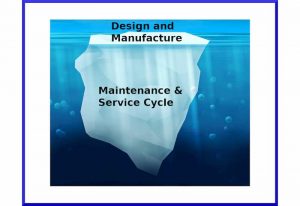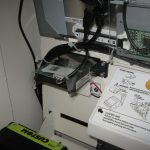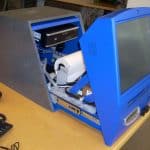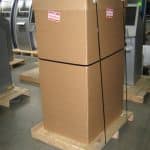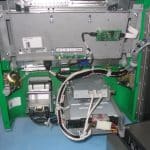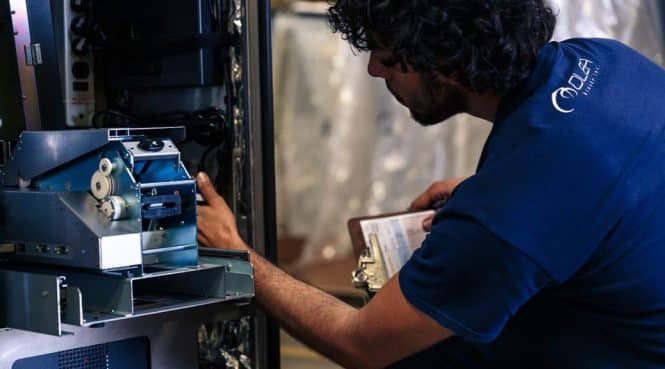
Kiosk Service and Kiosk Installation are red-headed stepchild
Kiosk service and kiosk installation and maintenance are almost always secondary considerations. You can throw in Training as well into that mix. Simple education prevents problems and problems generally start with tech onsite for $250 a pop (plus parts and labor)
Editors Note — We should probably include remote monitoring and alerts to the “often neglected”. All top-tier kiosk software companies will provide that function. One of our sponsors have dedicated resources just for remote monitoring ala carte solutions — Sitekiosk
For kiosk service and logistics we recommend
- Crane CPI has a complete service arm.
- Pitney Bowes — used to do kiosk service but now focusing on core clients
- For Europe, UK, EMEA in general we have recommendations. Orion and Chris Liveredge
Introduction – Kiosk Service & Kiosk Maintenance
There’s nothing that kills customer enthusiasm more for a kiosk deployment than walking up to a unit and seeing a piece of paper taped to the front bearing the hand-scrawled words “Out of order.”
Such a sight conveys the impression of neglect, and makes customers wonder what else the business operator is neglecting. And if they see that note on a subsequent visit, they’re unlikely to ever use the kiosk even if it’s eventually restored to a working condition.
The reputation of the entire kiosk industry rests on the shoulders of service providers, and anyone who treats service as an afterthought runs the risk of seeing their deployment turn into expensive dust collectors. Unfortunately, deployers often put service way down on their list of priorities when planning a self-service project.
Setting up for failure
Probably one of the most dramatic failures of a kiosk project in recent memory took place in Pennsylvania in 2011. The Pennsylvania Liquor Control Board shut down a project that used self-service kiosks to sell bottles of wine in dozens of supermarkets around the state. In addition to a complicated transaction process and an inexperienced vendor, service problems forced the board to shut down the kiosks for several weeks in December 2010, just as shoppers were planning to stock up on spirits for the holidays.
Although there were a number of issues with the project, it’s likely that the service problems alone would have prompted its collapse. And while most projects don’t attract the negative publicity that this one did, a variation of the old military saying holds true: poor planning, especially when it comes to service, will equal piss-poor performance. That can be avoided by considering service while a kiosk deployment is still in the budgeting and planning stage.
“With the service and support aspect of putting a piece of equipment out there, you’re probably looking at 15 to 20 percent on a yearly basis to fully support what’s out there,” said Luc Vallieres, CEO of Salt Lake City-based CSA Service Solutions, a nationwide provider of service solutions to a number of technology sectors. The company’s clients include such notables companies in self-service, retail and healthcare.
So if any of those kiosk market reports appearing on the Internet are to be believed, the service industry market is worth anywhere from $2 billion per year to $4 billion. So if the project budget is $100,000, anywhere from $15,000-20,000 should be earmarked for ongoing service. Whatever the size, it’s money well spent.
“It’s a waste of budget and resources to invest in implementing self-service hardware across your retail locations, but then fail to keep those devices updated and functional,” said Brad Fick, president of Minneapolis-based Direct Source, a provider of technology solutions for tier-one retailers.
“We always recommend quoting and setting up a hardware maintenance plan for three-to-five years after rollout,” Fick said. “This should be an important step in any retailer’s sourcing process.”
Unfortunately, though, many deployers overlook the importance of service. Another challenge can be that the implementation teams and the “after-roll-out” support teams are different.
“No matter what type of technology is being implemented, retailers have historically put service and device support on the back burner,” Fick said.
“Part of this is simply the excitement of a project and the focus on getting the technology right so customers or associates can start to use it in the stores,” he said. “How the tools are supported after roll-out can simply be overlooked.”
And in many cases, deployers secretly hope service won’t be an issue for several years after the project goes live.
“When purchasing a car, appliance or home electronics, you don’t think the device will fail because it’s new,” said Tony Lomazzo, VP of business development with Tyngsboro, Mass.-based Marathon Deployment. Marathon provides a full range of IT services with clients in the retail, hospitality and business services verticals around the world.
“When it comes to POS hardware and kiosks, though, you want to ensure your investment is protected on day one,” Lomazzo said. “This service needs to provide same day or next day onsite service. If your investment is inoperative this will cost you customers and will affect your bottom line. You should always protect your investment by adding the extended service.”
Editors Note – example
IMPLEMENTATION SERVICES
- Assistance with Multi-site deployment/installation Services
- Dedicate Rapid Response team for Break-fix/Service issues involving unattended solutions (i.e kiosks, EV chargers, access control, food lockers, etc.)
- Additional resources for Staging & Logistics
MANAGED / SUPPORT SERVICES
- 24/7 Live agent support
- Phone, email and online client systems
- Helpdesk integration with client systems
- Spare parts forward stock for End-Customer rapid response
Here are some real life pictures
- Looking inside
- Slide out service
- Shipping is very important
- What Tech Faces
Planning for Success
Servicing self-service devices is more complicated than just pasting a sticker with a toll-free number on the side of the kiosk enclosure.
Nick Manolis, CEO of the Dublin, Ireland-based Escher Group, advises his clients to prepare for a number of servicing activities. Escher provides kiosks, software and other technological solutions for 35 postal operations around the world.
The activities Manolis recommends deployers focus on include:
- Soft servicing – keeping the kiosk stocked, keeping receipt/label rolls full, emptying cash if the kiosk takes cash, and general “soft monitoring” of operation. If the kiosk is in a manned office, this may be done by local staff as one of their duties. If it is in a standalone location, then it will require a visit.
- Hard servicing – field maintenance (proactive and reactive) and general refurbishment. The kiosk needs to “look good,” especially if it’s your first point of contact with customers.
“Besides servicing the machine, companies also need to interact and follow up with the customer and/or the kiosk manufacturer,” Manolis said.
“A few things can be implemented to make this type of servicing easier, including alerting and self-reporting,” he said. “If the kiosk is not manned, then it should be able to ‘call home’ in the event of a problem such as a jam, paper low and so forth. Besides regular checks, the company needs to be regularly monitoring for both problems and non-use. The lack of use can also be indicative of an issue.”
Train Your Staff
On-site staff should be trained on basic maintenance such as changing receipt paper or rebooting the machine. The ability to monitor and troubleshoot problems remotely can be a major cost saver, especially if a technician needs to drive a long way for a site visit.
Screens need to be cleaned everyday and the right cleaners used. Think of walking into a hospital where basic cleaning doesn’t take place. Incidents like the one recently dramatised by UK tabloid newspapers and McDonalds resulted in some serious actions despite the nature of the report.
Service and maintenance by employees is a direct factor on how much service support you will need. Design the unit for easy servicing and maintenance and productivity will go up for both factors, and costs will go down for both.
Replacing paper in printers would seem to be a common task to train for, yet many times there is only one person who has taught themselves to do it.
Make sure the unit and components are designed to be serviced. Provide tools internally if necessary. Sometimes you can actually have customers do some of the servicing for you.
Ever grab a grocery cart at Krogers? Maybe you got one of the cleaning wipes out of the canister and wiped it down before taking into the store. Happens all the time and it helps keep the carts cleaner and safer.
Some real-life examples below:
Here is a credit application kiosk. Complete strangers and prospective customers approach and provide detailed information for a credit application. They get a printout. That printer requires paper replenishment (which is a good ROI indicator in itself). The problem is that the unit is designed so that employees leave the internal components accessible to anybody in order that they may easily change paper. But what if I were a bad hacker? The computer is exposed too, and I can just as easily insert a USB malware drive into the unit and record all the credit information entered. Perhaps I may be able to breach the actual office system and conceivably the corporate system..
It may make it easier to change paper but it is NOT the way to do it
Another real-life example would be cash cassettes. A super-major telecom provider with bill pay units had a severe cost problem with cash cassettes being damaged by employees when removed and re-inserted. They literally dropped them, often on the floor resulting in damage. Those costs were well over 300K a month just servicing those damaged cassettes. And it could have been averted by proper training.
In McDonalds, every one of those units has locks which operate to track and audit access by employees. They were designed in and they are not cheap, but in the overall scheme they are a bargain in the reduced service costs they might otherwise incurred. And it is worth noting that the original locks did not provide audit access but they were selected because they could easily be upgraded later to include auditing. That’s thinking ahead and saving yourself some budget. Look ahead and have a plan for success.
Types of Service Needs
In addition, service needs will vary depending on the type of service the unit provides. Informational and transactional self-service share much of the same technology, but their complexity varies greatly. Informational self-service projects are usually much smaller in scale with prepackaged software and information that can easily be rolled out to a self-service unit.
A transactional solution, on the other hand, is typically defined by its integration with a payment device or ecommerce module. With a transactional kiosk, there are more challenges around data security and payment processing. As such, transactional self-service projects are always more expensive and require more strategic planning.
<“Anything that’s transactional and helps drive revenue is likely going to require service much more quickly,” Vallieres said. “Anything that’s transactional and tied to the deployer’s business plan will typically have requests for a much quicker response time. If it’s informational, that may be a lot more flexible.”
| Software by Laura Miller of KioWare
Keeping kiosks healthy can be made easier with the use of kiosk management software. Tools that notify kiosk owners that maintenance is needed, paper is out, or the printer is jammed can optimize staff time and increase kiosk up time. The use of kiosk management software is just as important as staff availability for fixing hardware issues on site and keeping abreast of kiosk downtime. Utilizing kiosk system software and keeping that software up to date is another way to avoid security holes and downtime. Updating to the latest version available can reduce bugs, security holes, and other issues that can cause downtime. |
Having people maintain the kiosks and the hardware is one thing, but the maintenance of software over time, and the features that can assist with monitoring kiosk needs/health/states can be vitally important to the success of a project.
A changing approach
In addition to ensuring that kiosk uptime remains high, planning for service from project conception can have a major impact on the cost of that service.
While designers may approach a project from the perspective of how the kiosk looks, they don’t always consider serviceability. That’s something that can drive service costs through the roof.
“Speaking from experience, manufacturers sometimes think, hey, we’re going to put this box together and it ends up weighing 1,200 pounds or it needs to be bolted down, and the access panels are in the back,” Vallieres said. “Those are some of the issues that need to be taken into account that manufacturers don’t always think of.”
And who will provide that service is another issue that needs to be nailed down from the very beginning.
As the use of self-service devices in the marketplace changes and expands, so is the way service is provided. Some manufacturers offer service as part of a kiosk project, while others partner with third-party providers. In addition, the growth of the “gig economy” has spawned companies such as Field Nation, Upwork and others that make it possible for deployers to keep up with repairs and maintenance without the expense of an in-house service staff.
However they choose to approach it, though, deployers need to do their homework, talk with other deployers and examine the provider’s history.
“Design the software, the kiosk, the service aspects and the service plan for both Soft and Hard service needs all at the same time,” said Frank Olea, CEO of Olea Kiosks. “ And as time goes on, monitor your approach and adjust as needed. Don’t go it alone thinking you’ll figure it out when it happens. We don’t jump off cliffs and think about a parachute after the fact.”
Kiosk Service and Installation Related Links
- Crane CPI
- Pitney Bowes – Service & Logistics
- Kiosk Service
- Outdoor Kiosk
- Kiosk Maintenance tagged articles
- Touch Screen Monitor Maintenance — No Touch Kiosk No Touch Touch screen Kiosk
